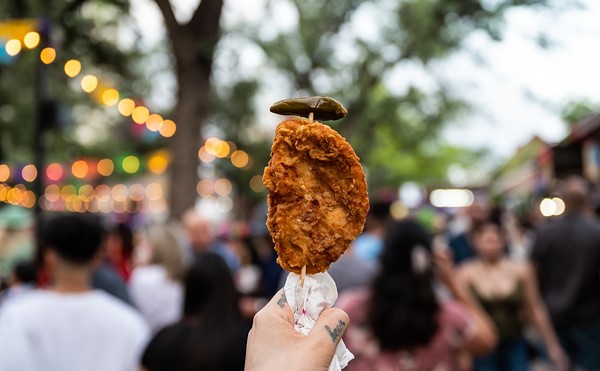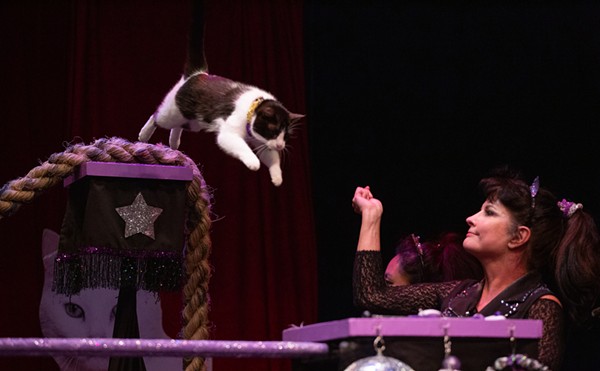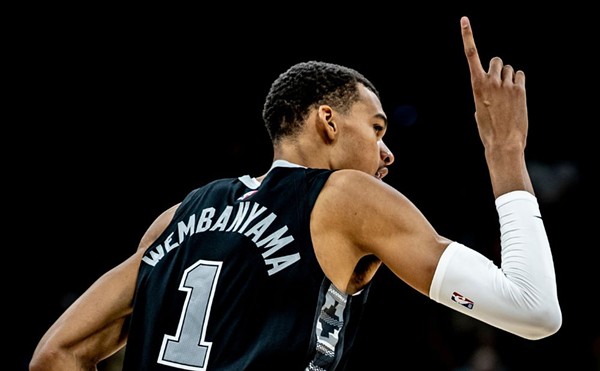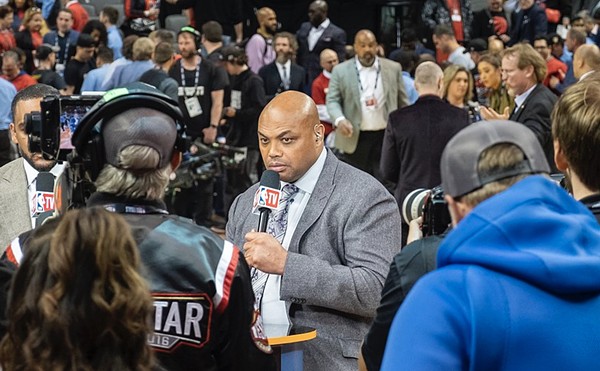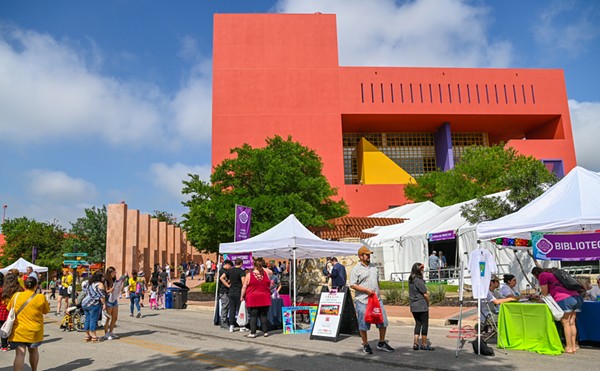Bettie Ward’s large-scale, collaborative threaded drawings are the star of her Blue Star retrospective, which opens this week, and rightfully so. While her abstract paintings are assured and accomplished, they’ve never been adventurous enough for my taste (it’s all too easy to imagine them hanging in the drawing room of a moneyed but conservative ranch house), but the embroideries are wild, and I’m not talking about the frequent sex and nudity. Beginning with the earliest versions created with her team of stitch-witches in San Miguel de Allende, the drawings have overflowed with rich dream imagery sparked by a desire to heal, understand, and bridge lost love and broken relationships, personal and global.
As with her exhibition two years ago at the Southwest School of Art & Craft, flowering cacti, military and circus performers, and provocatively undressed creatures cavort and signify on unbounded white-linen backgrounds. Prickly-pears, milagro hearts, and uniforms are prominent, and figures are often involved in symbolic exchanges or tight embraces. The thread colors are sometimes realistic (pink or peach for skin, blue or brown for eyes), other times fanciful (blue hair, a dog made of black-and-white spirals). What’s particularly interesting about this newer work is that unlike many artists, whose themes start out loose, messy, or undefined and grow increasingly focused and disciplined, Ward’s universe is becoming more crowded and chaotic, as if word is out in her subconscious about the open playground, and every day newly liberated thoughts show up to take a turn on the monkey bars. Visually, this pushes the work toward the folk-art and craft traditions, which is a way of saying that she seems to actively eschew the intellectual rigor expected of Art in favor of a joyous, unexamined expressionism. While some of the smaller works, such as 2007’s “Bully man with romantic notions,” and any of the various women having “relationships” with cacti, capture the singular folkloric primitivism of a Chagall or Gauguin that makes them art totems, unscathed by the mundane, Ward’s large-scale pieces — particularly the five-part “Optimism and Horror” series which gives the show its name — feel like they would be more wondrous off the wall, part of our daily lives: a very special tablecloth passed down through the generations until the unfurled coils of blue hair on the swimming woman have worn completely away.
As Ward notes in the catalog that’s being published to accompany the show, since she began working with her team of embroiderers in Mexico — Lupe, Luz Ma, Beatriz, and Irma — 10 years ago, their craft has evolved, and some of the stitchery on these works is captivating in its detail and inventiveness, particularly in the hairdos, the gorgeous flora, and the dogs. In art, of course, details don’t necessarily make a whole, and sometimes the wholes don’t hang together for me, as if they are assembly-line products that draw from a catalog of acceptable design references — as if that ephemeral thing we call an artist’s vision or soul doesn’t make the final transition from sketch to finished piece. That could just be a projection based on my bias for the Western great-(wo)man theory of art — a philosophy that Ward’s threaded drawings confront directly and subconsciously. No coincidence, either, that Ward’s pieces are filled with imagery addressing war and human conflict, exploitation and unequal power relationships.
Although there is still a hierarchy in Ward’s relationship with her San Miguel collective (only their first names appear on the works; Ward is clearly the creator, they are the helpmates), the collaborative project itself is an implicit rebuttal to the maquiladora system — and outsourcing in general — in which goods are produced across the border by faceless laborers, who are paid less than U.S. workers and who often lack basic labor protections. In that sense, the threaded drawings represent the outcome of a performance piece — one that is as much a part of Ward’s evolution as an artist and human being as the images’ subject matter.
Two years ago, Ward, a lifelong musician, vowed to perform at the opening for this show, and she will headline her jazz band, Queenie and the Bumblebees, which includes George and Aaron Prado, Thursday evening at the Blue Star members’ reception. She’s also performing Friday night at a private party at Tresca with her rock band, Rosebud and the All Night Boys, featuring Mark Little, brother of sculptor Ken Little. (Note: Tresca is one of the restaurants in which my husband is a partner, though I didn’t know she had booked a party there when I previewed her show.) In the context of the art show, the musical performances feel like a way of baring another part of herself to the audience, to say, here’s my creative mind and soul — you sort it out. Or better yet, get your own junk out on the table and let’s see if we can make a more beautiful world with it. •
VISUAL ART
Optimism & Horror: Bettie Ward
Through Mar 15
Free
Blue Star Contemporary Art Center
112 Blue Star
(210) 227-6960
bluestarart.org





